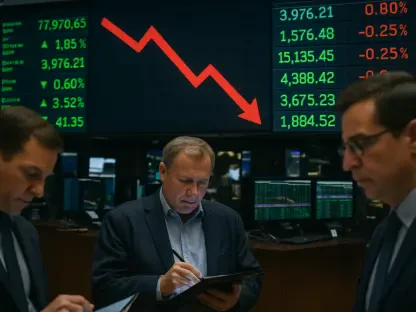The cryptocurrency market is undergoing a seismic shift with the emergence of Ethereum spot Exchange-Traded Funds (ETFs), a development that could fundamentally alter how investors engage with digital assets. As the second-largest cryptocurrency by market capitalization, Ethereum has long been a cornerstone of the blockchain ecosystem, powering decentralized applications and smart contracts. Now, with the introduction of spot ETFs, investors can gain exposure to Ethereum’s price fluctuations without the complexities of direct ownership, such as managing private keys or navigating crypto exchanges. This fusion of traditional financial instruments with cutting-edge digital assets raises intriguing possibilities for both retail and institutional players. It also sparks debate about whether these regulated products can truly embody the ethos of crypto while offering a safer, more accessible entry point. This exploration delves into the implications, challenges, and potential of Ethereum spot ETFs as a transformative force in the investment landscape.
Tension Between Decentralization and Centralization
The advent of Ethereum spot ETFs highlights a profound ideological conflict within the cryptocurrency space, pitting the principle of decentralization against the centralized framework of traditional finance. Cryptocurrencies were originally designed to empower individuals by eliminating intermediaries, allowing users to maintain full control over their assets through private keys and peer-to-peer transactions. Ethereum, with its robust blockchain, epitomizes this vision of a trustless system. Yet, spot ETFs disrupt this model by introducing fund managers and custodians who hold the underlying Ethereum on behalf of investors. This reintroduction of third parties mirrors the very structures crypto sought to bypass, raising concerns about whether the convenience of ETFs comes at the cost of the sector’s foundational values. For many purists, this shift feels like a step backward, as it places trust in centralized entities that could be prone to mismanagement or external pressures, challenging the core tenets of blockchain technology.
Beyond the philosophical debate, the practical implications of this centralization are significant for investors considering Ethereum spot ETFs as a vehicle for exposure. While these ETFs provide a streamlined way to invest without the technical hurdles of crypto ownership, they also mean relinquishing direct control over the asset. Investors must rely on the security measures and operational integrity of custodians, which introduces a layer of risk not present in self-managed wallets. Furthermore, the involvement of traditional financial institutions could influence how Ethereum’s value is perceived and traded, potentially aligning it more closely with conventional market dynamics rather than the decentralized ethos that has driven its growth. This dynamic creates a paradox: while ETFs aim to broaden access to Ethereum, they may also reshape its identity within the broader financial ecosystem, prompting a reevaluation of what it means to invest in a truly decentralized asset.
Navigating the Regulatory Landscape
The regulatory environment surrounding Ethereum spot ETFs plays a pivotal role in their adoption and long-term viability, offering both validation and uncertainty for the cryptocurrency market. The U.S. Securities and Exchange Commission (SEC) has recently approved these ETFs, a landmark decision that signals Ethereum’s legitimacy as a financial asset worthy of institutional attention. This approval provides a structured pathway for investors, ensuring transparency and oversight that can stabilize market participation. It also reflects a growing acceptance of digital assets within mainstream finance, potentially paving the way for further integration. However, while this milestone boosts confidence, the regulatory framework remains fluid. Ongoing debates about staking rewards and their classification as securities, alongside potential policy shifts, create a backdrop of uncertainty that could impact the trajectory of these investment vehicles.
On a global scale, the regulatory outlook for Ethereum spot ETFs varies widely, adding another layer of complexity for investors and market participants. Some jurisdictions have embraced clear and supportive guidelines, fostering rapid adoption and positioning themselves as hubs for crypto innovation. Others, however, remain hesitant, with ambiguous or restrictive policies that could hinder the growth of these ETFs in certain regions. This patchwork of regulations means that the success of Ethereum spot ETFs may depend heavily on where an investor is located, as well as how agile regulators are in adapting to the evolving nature of digital assets. For now, the SEC’s approval stands as a significant step forward, but the path ahead is far from certain. Investors must stay attuned to policy developments, as changes in the regulatory climate could either accelerate the mainstreaming of Ethereum ETFs or pose unexpected obstacles to their widespread acceptance.
Unveiling Hidden Risks and Challenges
While Ethereum spot ETFs offer a user-friendly entry into the crypto market, they carry underlying risks that may not be immediately apparent to those accustomed to traditional investments. A primary concern is asset concentration, as these ETFs are exclusively tied to Ethereum’s price movements, leaving investors fully exposed to its volatility. Unlike diversified funds, there’s no buffer against the sharp ups and downs that characterize the cryptocurrency market. Additionally, the reliance on custodians to secure the underlying assets introduces vulnerabilities, such as the potential for security breaches or operational failures. These risks are compounded by the fact that many investors may not fully grasp the technical intricacies of how their assets are managed, making it crucial to scrutinize the credibility and track record of the entities behind these ETFs before diving in.
Another often-overlooked challenge with Ethereum spot ETFs is the possibility of tracking errors, where the fund’s performance deviates from Ethereum’s actual price due to management fees or inefficiencies. Such discrepancies can erode returns over time, particularly for long-term holders who might expect a near-perfect correlation. Regulatory uncertainty adds yet another dimension of risk, as evolving policies could alter how these ETFs operate or are taxed, potentially affecting their appeal. For instance, debates over staking and its legal classification could introduce unforeseen complications. These hidden pitfalls underscore the importance of due diligence, as the apparent simplicity of investing through an ETF does not eliminate the inherent complexities of the crypto space. Investors must weigh these challenges against the benefits, recognizing that even regulated products carry unique risks that demand careful consideration.
Bridging Accessibility and Institutional Priorities
Ethereum spot ETFs are reshaping the accessibility of cryptocurrency investments, offering a simplified pathway for retail investors who might otherwise shy away from the technical demands of direct ownership. By allowing individuals to purchase shares through familiar brokerage accounts, these ETFs remove the need to manage digital wallets or navigate the often-intimidating world of crypto exchanges. This ease of access extends even to retirement accounts, where ETFs can be included as part of a diversified portfolio, making Ethereum a viable option for long-term financial planning. For many, this represents a significant step toward democratizing crypto investment, breaking down barriers that have historically limited participation to tech-savvy enthusiasts or those willing to tackle the learning curve associated with blockchain technology.
However, while retail investors stand to gain from this increased accessibility, the structure of Ethereum spot ETFs often appears tailored more to the needs of institutional players, creating an imbalance in focus. Large financial entities prioritize compliance, seamless integration into existing portfolios, and regulatory clarity—elements that ETFs are designed to address. This institutional emphasis drives substantial capital inflows, enhancing liquidity and potentially stabilizing Ethereum’s market presence. Yet, it also means that the unique needs of smaller investors, such as lower fees or educational support, might take a backseat. As these ETFs continue to evolve, the challenge lies in ensuring that the benefits of broader access are not overshadowed by a system that caters predominantly to bigger players. Striking a balance between these priorities will be key to maximizing the transformative potential of Ethereum spot ETFs across the investment spectrum.
Shaping the Next Era of Digital Assets
Reflecting on the journey of Ethereum spot ETFs, their emergence marks a pivotal moment in blending the innovative spirit of cryptocurrency with the structured world of traditional finance. Their approval by regulatory bodies like the SEC provided a stamp of legitimacy, drawing significant institutional interest and stabilizing market dynamics through regulated channels. At the same time, these ETFs broadened access for everyday investors, simplifying participation in a once-complex space. Yet, challenges persist, from the erosion of decentralization to the hidden risks of volatility and custodial reliance, reminding stakeholders of the delicate balance between convenience and core crypto principles.
Looking ahead, the evolution of Ethereum spot ETFs offers a roadmap for navigating the future of digital asset investment. Investors should prioritize staying informed about regulatory shifts and conducting thorough research into the operational integrity of ETF providers. Policymakers, meanwhile, face the task of crafting frameworks that foster innovation without compromising investor protection. As the crypto market matures, these ETFs could serve as a model for integrating other digital assets into mainstream finance, provided the industry addresses the inherent tensions and risks. The next steps involve fostering dialogue between regulators, investors, and crypto advocates to ensure that this financial instrument continues to bridge gaps while preserving the transformative essence of blockchain technology.









